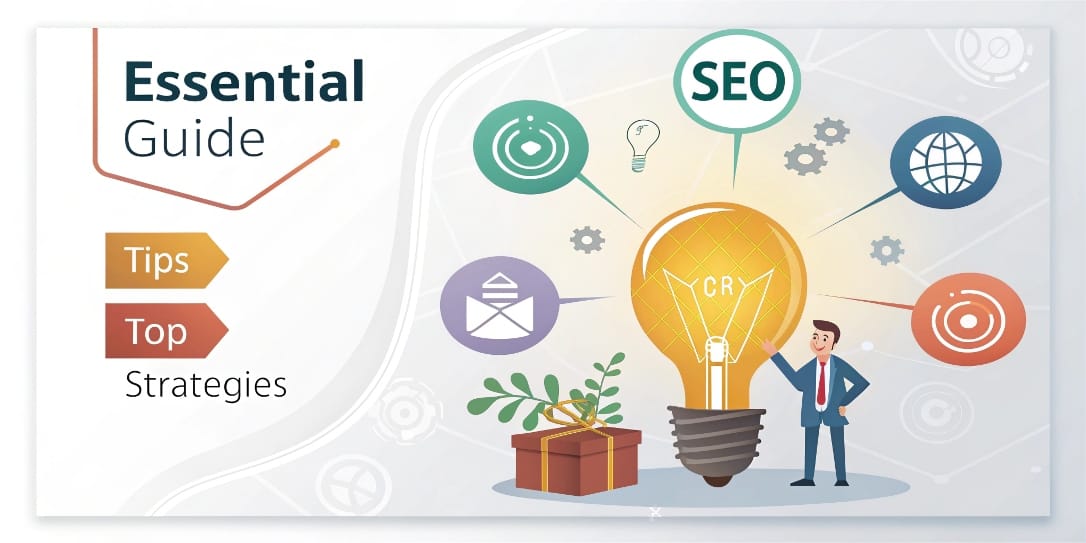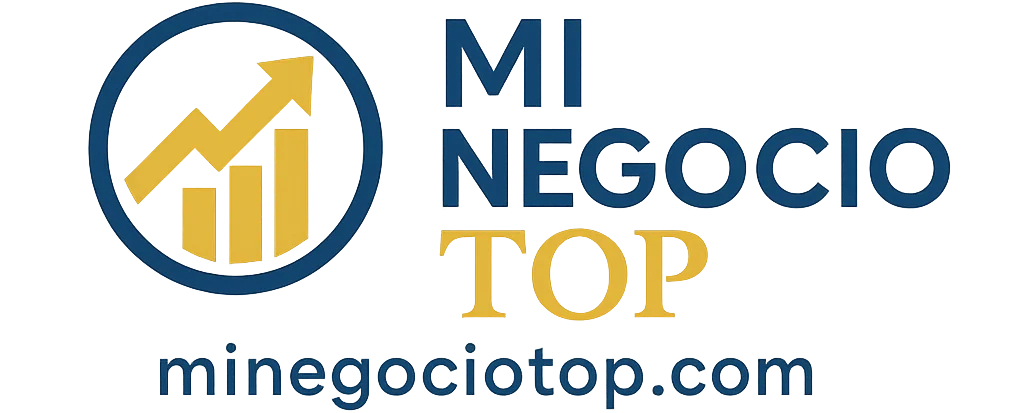SEO for businesses is, without exaggeration, the most important factor in being visible in today’s digital world. When a potential customer searches for what you offer on Google or other search engines, your business needs to show up on the first page. If you’re not there, you’re leaving the door wide open for your competitors.
Understanding and applying SEO isn’t just a tech task—it’s a strategic way to attract qualified customers who are already looking to buy. At MyTopBusiness.com, based on our hands-on experience helping small and medium-sized businesses improve their online presence, we share proven methods and exclusive tips to help you master SEO and boost your profitability.

Your Digital Storefront: How SEO Works and Why It Matters
SEO stands for “Search Engine Optimization.” In simple terms, it’s a set of techniques that help search engines like Google, Bing, or DuckDuckGo understand your website better and consider it a top result for relevant searches.
Think of Google as a massive business directory. SEO is what helps your business stand out and show up when someone searches for your products or services.
Why is SEO essential for your business?
- Most online purchase decisions begin with a search.
- Organic traffic (visits from unpaid search results) is usually the most qualified because people are actively looking for what you offer.
- SEO is a long-term investment that, when done right, brings a steady stream of potential customers—without paying for each click.
- It helps establish your authority and credibility in your industry.
Ignoring SEO is like opening a fantastic store but hiding it in an alley with no sign. No one will find you unless they already know you exist.
The Core Areas of SEO You Need to Master
While SEO has many components, these are the ones that offer the best return for your time and effort:
Keyword Research: Your First Strategic Step
What words or phrases does your ideal customer type when searching for what you offer? These are called keywords.
Don’t assume—research. Use free or paid keyword tools to discover:
- The most relevant search terms in your niche.
- How often people search for them (search volume).
- How hard it is to rank for them (competition).
💡 Pro Tip from MyTopBusiness: Focus on keywords with a solid search volume and a clear buying intent. For example, “digital marketing course” is broad, but “buy online marketing course for small business” shows someone is ready to take action. Look for long-tail keywords—longer, more specific phrases with lower competition and higher conversion potential.
On-Page SEO: Make Your Website Speak Google’s Language (and Your Customers’)
This is about optimizing your website’s content and structure to appeal to both users and search engines. Think of it as setting up your virtual storefront to be clear, inviting, and effective.
Key on-page elements to optimize:
- Title Tag: Appears in the browser tab and search results. Make it catchy, include your main keyword, and your business name if relevant. (Max 60 characters.)
- Meta Description: The short summary below your title in search results. Doesn’t directly impact rankings but affects click-through rate (CTR). (Max 155 characters.)
- Headings (H1, H2, H3…): Use clear headings to organize content. The H1 should include your primary keyword and match your page title. H2s and H3s guide both users and Google.
- High-Value Content: Your text should be original, helpful, and naturally include your keywords (main and related). Always write for people first, not just algorithms.
- Images: Compress images to load fast and add descriptive alt text with relevant keywords for accessibility and SEO.
- Internal Links: Connect related pages within your site. For example, link this guide to a detailed article about [Image Optimization for SEO] or [How to Write SEO-Friendly Product Descriptions].
Basic Technical SEO: Make Sure Your Website Is Fast and Functional
This part focuses on your website’s technical infrastructure. Even if you’re not a developer, you or your team can handle the basics.
Essential technical factors:
- Page Speed: A slow site drives visitors away. Optimize images, enable caching, and use reliable hosting. Use free tools like Google PageSpeed Insights.
- Mobile-Friendliness: Most people browse on phones. If your site isn’t mobile-optimized, Google will penalize it.
- Site Structure: Use clear menus, categories, and internal links. This helps both users and Google understand and navigate your content.
- HTTPS Security: Secure your site with HTTPS. It’s a basic trust signal and a ranking factor.
- XML Sitemap: Submit a sitemap to Google Search Console to ensure all important pages are indexed.
- Clean URLs: Use short, descriptive URLs with keywords. Example:
mytopbusiness.com/digital-marketing/seo-tipsis better thanmytopbusiness.com/p?id=123.
Off-Page SEO: Build Your Website’s Reputation
Off-page SEO refers to what happens outside your site that impacts your rankings. The biggest factor: backlinks—links from other websites to yours.
How to build a strong off-page presence:
- Backlinks: Quality matters more than quantity. A link from a respected site in your niche is worth far more than dozens of low-quality ones. Earn backlinks through:
- Exceptional content people want to share.
- Guest posting on reputable blogs.
- Building partnerships with other businesses.
- Brand Mentions: Even unlinked mentions of your brand on blogs, news sites, or social media boost visibility and authority.
- Local Citations: For brick-and-mortar businesses, being listed in directories (Yelp, local chambers of commerce, Google Maps) with consistent Name, Address, and Phone (NAP) data is essential for Local SEO.
Local SEO: A Must-Have for Physical and Service-Based Businesses
If you have a physical location or serve a specific geographic area, Local SEO is crucial. It helps your business appear in “near me” searches and local map results.
Local SEO best practices:
- Google Business Profile: Claim and fully optimize your listing. Keep your name, address, and phone number (NAP) accurate and updated. Add photos, describe services, answer questions, and respond to reviews.
- NAP Consistency: Your business info must be exactly the same across all directories, social media, and your website.
- Customer Reviews: Encourage happy customers to leave reviews on Google, Facebook, Yelp, etc.—and respond to them all.
- Local Keywords: Use geographic terms in your content and meta tags. Example: “custom bakery in Austin,” “family lawyer in Toronto,” “office cleaning in Miami.”
Measuring SEO: How to Know If It’s Working
Doing SEO without tracking results is like flying blind. Use analytics to see what’s working—and what needs improvement.
Free essential tools and key metrics:
- Google Analytics: Understand who visits your site, how they found you, which pages they explore, and more.
- Google Search Console: See how Google views your site, which keywords you rank for, average position, and technical issues.
Track these key performance indicators (KPIs):
- Organic Traffic: Visitors from search engines—your main visibility metric.
- Click-Through Rate (CTR): How often people click your listing in search results.
- Bounce Rate: The percentage of visitors who leave after viewing only one page. A high rate could mean your content doesn’t meet expectations.
- Time on Page: The longer visitors stay, the more valuable your content is.
- Conversions: Ultimately, how many leads, sales, or inquiries come from organic traffic?
How AI Can Support Your SEO Strategy
AI is becoming a powerful tool to help business owners save time and work smarter with SEO.
Ways AI can support your strategy:
- Keyword Research: AI tools can generate and group keyword ideas faster.
- Content Creation: AI can help draft blog posts, product descriptions, and meta tags.
- Data Analysis: AI can process SEO data quickly to identify trends and opportunities.
Remember: AI is a tool, not a strategy. Human experience, creativity, and understanding your customer are irreplaceable.
The Real Goal of SEO: More Visibility, More Clients, More Profit
At MyTopBusiness.com, we see SEO not just as a way to rank on Google—but as a growth strategy. Every SEO effort has one clear goal:
- Boost visibility so more people find you.
- Attract qualified leads who are actively searching for your offer.
- Convert leads into paying customers.
- Increase profitability by making each sale more efficient and less costly.
SEO is one of the most cost-effective ways to grow your business long-term when done with a clear, consistent strategy.
Practical SEO Tips That Work for Businesses Like Yours
- ✅ Focus on Search Intent: Don’t just target keywords—solve problems. Use synonyms and related terms (LSI keywords) to match what people are really searching for.
- ✅ Local SEO = Quick Wins: If you serve a local area, optimize your Google Business Profile today and collect reviews. It’s one of the fastest ways to get clients.
- ✅ Content That Solves Real Questions: Write blog posts or guides that directly answer what your potential clients are asking. For example, “How to choose the best [your product/service]?”
- ✅ Don’t Underestimate User Experience: Page speed and mobile usability aren’t just tech issues—they’re SEO factors. A smooth experience means better rankings.
Common SEO Questions Answered
How long does SEO take to show results?
SEO is a mid-to-long-term strategy. Most businesses start seeing results (better rankings and more traffic) within 4–12 months. Patience and consistency are key.
Do I need to be a tech expert to do SEO?
Not at all! Most impactful strategies (keyword research, on-page SEO, content creation, local optimization) are learnable. For more technical tasks, you can ask your developer or team for help.
Is SEO only for online businesses?
Definitely not! SEO is vital for any business that wants to be found online—whether you’re e-commerce, a local shop, or a service provider.
Can I do SEO for free?
Yes! SEO is largely about effort, knowledge, and using free tools wisely (like Google Analytics, Search Console, and Google Business Profile). Our content at MyTopBusiness.com is here to guide you every step of the way.
Your Next Step: Start Growing with SEO
SEO is your ticket to online visibility and sustainable growth. In this guide, you’ve learned the essential pillars of SEO for business. To go deeper on each topic (keywords, on-page optimization, local SEO, etc.), explore our full library in the [Digital Marketing & Sales Strategy Hub].
Every SEO step you take helps more people find your business, become customers, and improve your bottom line.
🎯 [Explore More Digital Marketing Strategies for Your Business]
